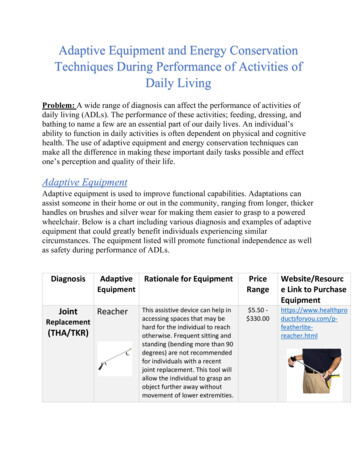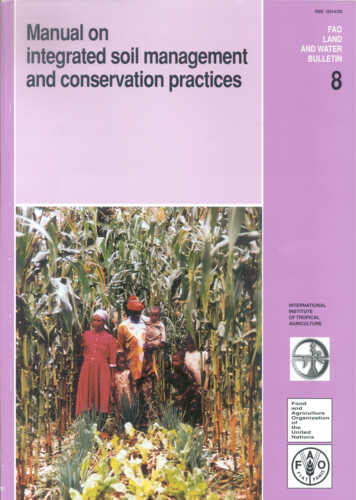
Transcription
Adaptive Equipment and Energy ConservationTechniques During Performance of Activities ofDaily LivingProblem: A wide range of diagnosis can affect the performance of activities ofdaily living (ADLs). The performance of these activities; feeding, dressing, andbathing to name a few are an essential part of our daily lives. An individual’sability to function in daily activities is often dependent on physical and cognitivehealth. The use of adaptive equipment and energy conservation techniques canmake all the difference in making these important daily tasks possible and effectone’s perception and quality of their life.Adaptive EquipmentAdaptive equipment is used to improve functional capabilities. Adaptations canassist someone in their home or out in the community, ranging from longer, thickerhandles on brushes and silver wear for making them easier to grasp to a poweredwheelchair. Below is a chart including various diagnosis and examples of adaptiveequipment that could greatly benefit individuals experiencing similarcircumstances. The equipment listed will promote functional independence as wellas safety during performance of ADLs.DiagnosisJointReplacement(THA/TKR)Adaptive Rationale for EquipmentEquipmentPriceRangeWebsite/Resource Link to PurchaseEquipmentReacher 5.50 rlitereacher.htmlThis assistive device can help inaccessing spaces that may behard for the individual to reachotherwise. Frequent sitting andstanding (bending more than 90degrees) are not recommendedfor individuals with a recentjoint replacement. This tool willallow the individual to grasp anobject further away withoutmovement of lower extremities.
Sock aidLonghandledshoehornRaisedtoilet seatAfter having a jointreplacement, it is veryimportant to limit a large rangeof motion at the hip/knee.Putting on socks requiresbending and reaching, however,using a sock aid can greatly limitthe range of motion requiredwhen performing this task;sliding the sock over the sock aidand lowering it to the floor usingattached ropes. Sock aids cangreatly ease dressing tasks aftera joint replacement.Many times, when putting shoeson it is convenient to bring yourfoot closer to you to make thetask easier, however, after ajoint replacement, it isrecommended to avoid steppingbackwards, crossing your legs,or bending more than 90degrees at the joint. A longhandled shoehorn is medicallynecessary to ensureunnecessary movements areminimal.Minimizing bending theoperated joint is extremelyimportant after having a jointreplacement surgery. Usingadaptive equipment to limitrange of motion at the hip/kneewill allow for adequate time forhealing and reduce risk of injury. 7.00 ide-style-sockaid.html 1.50 e-medical-getyour-shoe-on-plasticshoehorn.html 20.00 premium-seatrizer-with-removablearms.html
UnsteadyGaitBathroomgrab barsThis assistive device can providesupport and stability for anindividual after a jointreplacement. Maintainingbalance during bathing by usinggrab bars with textured handleswill greatly increase safety anddecrease fall risks on slipperysurfaces. 20.00 textured-wallgrab-bars.htmlTubtransferbenchShaking and poor balance arecommon symptoms ofParkinson's disease, **** .Individuals who easily have lossof balance need extra support tocompensate for the energy thatis constantly being used duringtremors and shaking. A tubtransfer bench will provide theadditional support that isnecessary during bathing.A walker can have a profoundeffect on stability for individualswith walking difficulties.Stiffness is often anothercommon symptom that occurswith unsteady walking, makingthis assistive device medicallynecessary. A walker can act as asupport for functional mobilitywhile greatly increasing safety. 30.00 x-imperialcollection-transferbench.html 45.00 mlThe heaviness of weightedutensils reduces the effect oftremors by steadying the hand.Also help with lack ofcoordination by providing moresensory feedback. Significantlysmoother movements make iteasier to scoop up food andbring it to the mouth. Thisassistive device is medicallynecessary during self-feeding forsomeone with tremors. 3.00 sils
ScoopdishChronic, Powerprogressive wheelchairillnessRampTremors can have a profoundimpact on coordination andcontrol of the arms and hands. Ascoop dish can be used to avoidfood being pushed off the edgeof the bowl and prevent spillsduring feeding and eating. Thisadaptive equipment isimportant for feeding to be anindependent task.An electric wheelchair is anassistive device that can give theindividual a sense ofindependence whencomplications increase. Electricwheelchairs are highlyadjustable to patients’ specificneeds and can assist withpressure relief, posturalalignment, sitting tolerance, andindependent repositioning. Thisadaptive device will increaseindependence and safety. Apower wheelchair is capable ofadjusting to specific needs ofthe individual, making it amedical necessity.Progressive muscle weaknessand paralysis are symptoms thatare sometimes seen at endstages of debilitating illnesses. Aramp is an assistive devicewhich is often placed over stairsor uneven surfaces. A ramp ismedically necessary to allow anindividual using a wheelchair toget in and out of their home. 6.00 py-scoop-dishplate.html 1,700.00 - https://www.healthpro 19,638.00 r.html 30.00 rtable-mutlifoldramp.html
HospitalbedArthritisTreatment options are oftenlimited for progressive diseases,making the comfort and safetyof the patient a top priority.Without a hospital bed there isan increase for complications toarise such as bedsores,thrombosis, pneumonia (due tolack of upright position), UTI,and osteoporosis, making ahospital bed necessary for achronic, progressive disease.An electric can opener can makeit both safer and easier forgetting the lid off a can. By usingthis assistive device anindividual with arthritis willavoid putting the extra tensionand stress on their bones. It ismedically necessary to preventexacerbations and discomfort,which cause intense stiffnessand discomfort in the joints. 50.00 am-field-patriothospital-bed.html 25.00 s assistive device will limitthe need to reach when bathing.Arthritis symptoms includingjoint stiffness, pain, andinflammation make the longhandled sponge is medicallynecessary to supportindependent grooming andbathing for an individual with alimited range of motion. 3.50 mlRockerknife withbuilt uphandleThe rocker knife requires lesspressure than a regular utensilwhen cutting food, the built-uphandle will add less stress oninflamed or weak joints.Arthritis is especially prevalentin the hands and fingers; thisassistive device is medicallynecessary for self-feeding andindependence. 3.00 iccanopener
Low Visual ContrastAcuitytapeBump dotstickersPortableelectricmagnifierOutlining edges of counter tops,steps, coffee tables, doorways,and bathtubs/showers with bluetape makes them easier todistinguish. Without contrasts,the likeliness of falls andaccidents are increased.Contrast tape is medicallynecessary to ensure safety ofindividuals with decreased visualacuity.This adaptive tool with give theindividual tactile cues to hitappropriate buttons when usingthe microwave, oven, stove,remote, or phone in their home.Without these stickers, turningon the wrong burner on thestove or setting the temperaturetoo high on the oven is muchmore likely, making themmedically necessary for safety. 19.95 -tape-blackand-yellow-striped 10.00 lors/dp/B00II5TM6WA portable electric magnifier willallow the individual to readlabels, prescriptions, andappointment dates. This devicecan be used easily in the homeby either laying it flat over thesurface and sliding it along toread or slide camera over thetext with the screen set upbehind the material being readand read off the device screen. 200.00 y-shoppaportable-electronicmagnifier.html
Energy ConservationEnergy conservation techniques is a less physical way of adapting the way dailyactivities within the environment. Making simple adjustments to daily routines canimprove energy efficiency, and ultimately conserve energy throughout the day.Energy conservation techniques can be applied to any aspect of life; at home,work, leisure, and even rest/sleep. The 6 P’s below are important to keep in mindto help conserve energy.Energy Conservation Techniques - 6 P’s1. Prioritize: Set realistic goals and prioritize dailyactivities2. Plan: Break down task into stages3. Positioning: Sit down and take restbreaks, avoid prolonged movements andtiring posture.4. Pace yourself: Allow extra time to complete anactivity and don’t rush5. Positive attitude: Concentrate on all the things youcan do6. Pursed lip breathing: Inhale through nose,exhale through 18/02/PL721.pdf
The areas of feeding, dressing, and bathing are assessed as examples ofapplying ideas of energy conservation techniques to everyday life:Eating & Feeding§ Plan ahead and avoid rushing§ Schedule meal prepping throughout the week§ Organize grocery list by aisle§ Shop at less busy times§ Sit when preparing meals§ Make use of electrical appliances; blender, dishwasher, etc.§ Use grocery cart for or-conserving-yourenergyDressing§ Lay out clothes before getting dressed§ Sit down to dress and undress§ Minimize leaning over to get dressed. Bringfoot up next to you to get socks on, fastenbra in front then turn it to the back.§ Consider the type of clothing; a t-shirt instead of a button up orpants with an elastic band instead of buttonsBathing§ Use a shower organizer to decreasereaching§ Make use of electrical tools; toothbrushes,shavers, etc.§ Toothbrush with built up handle§ Sit during bathing and take rest on-wheels-mow
Solutions for bathing with low enduranceBathing at regular intervals (at least 1-2 times per week) is necessary for seniors to maintain skinintegrity, reduce the risk for skin breakdown and infections, eliminate body odor and to maintainhygiene. Biological aging is associated with declines in neuromuscular and cardiovascularsystems, and this can impact activities of daily living (ADLs) due to an impaired capacity forwork (Cadore et al., 2014). Low endurance can be exacerbated by cardiopulmonary orcardiovascular disease, cancer, autoimmune diseases, and other unspecified etiologies.Participation in ADLs such as bathing can be limited or require assistance from a caregiver tocomplete due to many factors including decreased endurance. An estimated 2% of the adultpopulation requires some assistance to complete ADLs, with 12% of adults over 75 requiringassistance (Adams et al., 2012). The lifetime probability of experiencing a disability in at least 2ADL areas is as high as 68% for people over the age of 65 (Adams et al., 2012).The following information can assist to maximize independence with showering and bathing tominimize the physical effort required.Assistive devicesShower chair and handheld shower head. Remaining seated on the bench while showeringwill reduce the overall effort required for showering.https://www.youtube.com/watch?v KXCPlrQ682c
Long handled sponge will reduce the overall effort by requiring less bending and reaching toefficiently and effectively wash all areas of your bodyhttps://www.youtube.com/watch?v Iar-gwBeVGAActivity modifications-Reduce standing time: sitting requires less energy so complete as much of the bathing activitywhile seated as possible including undressing, drying off, dressing,-Keep items within reach: utilize ledges in shower or install shelving in shower to storesupplies such as shampoo, soap and conditioner. Keep your towel and any other necessarysupplies within reach so you can remain sitting to retrieve them.-Temperature: heat can exacerbate fatigue, reducing the temperature of the water can help youconserve energy for other bathing tasksImpact on OccupationImplementing these energy saving modifications can help you to maximize yourindependence and safety with bathing tasks.
Example: An older individual who lives alone may be unable to safely bathe themselves dueto low endurance. Utilizing the shower chair along with other modifications will allow thisperson to safely and effectively complete the bathing task on their own without theassistance of a caregiver.SafetySafety is the number one concern during bathing activities. If you feel unsteady, have had arecent fall or loss of consciousness please consult your primary care physician prior toimplementing any new techniques.ConsultIf your cause for low endurance is unknown, discuss it with your primary care physician to makesure it is not something more serious. Speak to your primary care provider about any additionalchallenges low endurance may cause and request an occupational therapy home evaluation tolearn more energy conservation techniques.Community resources-Find a handyman to install handheld shower head, shower seat, shower shelving and otherageing in place essentials: https://handymanconnection.com/-Loan closet to get equipment at low or no cost https://loanclosets.org/michigan/wayne-Purchase equipment: http://www.binsons.com/site search.html and search for desired itemReferences:Adams, P. F., Kirzinger, W. K., Martinez, M. E. (2012) Summary health statistics for the U.S.population: National health interview survey, 2011. Vital Health Statistics, (10)255, 1-110.Cadore, E. L., Pinto, R. S., Bottaro, M., & Izquierdo, M. (2014). Strength and endurance trainingprescription in healthy and frail elderly. Aging and Disease, 5(3), 183-195.
ResourcesMeals on Wheels: An alternative option for meal prepping and cooking at home ishaving healthy meals brought right to seniors’ homes fully ls-on-wheels-mowHelloFresh: A service such as Hello Fresh, if able to prepare their meal at home.This can be helpful in ensuring the quality of their meals and eliminate the task ofgrocery shopping and having unhealthy choices. Both Meals on Wheels and HelloFresh are examples of energy conservation techniques for meals.Michigan Assistive Technology Program (MATP): This program works with otherorganizations in Michigan to provide demonstrations to people who havedisabilities to help to compare and contrast adaptive equipment options, so they areable to make informed nline Tools - https://atxchange.org/ : An online site people can donate or selladaptive equipment of all kinds (provided through MATP). Equipment rangingfrom power wheelchairs to computer monitors and software are available.Further Professional AssistanceDementia is a progressive disease and staying physically active has a big impact onthe well-being of the individual experiencing dementia. Physical, occupational, andrecreational could greatly benefit someone with a physical disability.-Physical therapy: Increase strength, endurance, and safety for the individual;making a daily exercise program and providing specialized care.-Occupational therapy: Help in assisting in ADLs and provide continuoussupport with compensatory strategies and adaptive equipment, including thoselisted above, to increase meaningful activities qualityof life overall. Feeding and eating can also beassessed if swallowing issues are present.-Recreational therapy: Provide leisure andrecreational activities for the individual as well asassist in identifying leisure pursuits and hobbies topromote physical activity.
Improving Occupational Engagement – Further ConsiderationsTreatment approaches relating to adaptive equipment and compensatory techniquestrategies can be applied to anyone’s daily life to make a task easier. If a client hada physical disability such as limited range of motion both adaptive equipment andcompensatory strategies could be very useful. For example, after a hip surgeryusing an elevated toilet seat or shower chair for safety and to avoid falls could bevery beneficial. Energy conservation techniques that could be used would be to sitdown during dressing activities and take their time completing daily tasks.An individual’s ability to function in daily activities is often dependent on physicaland cognitive health. Finding personal strategies within the environment toconserve energy paired with the use of necessary adaptive equipment can make allthe difference in making these important daily tasks possible and effect one’sperception and quality of their life.Age-related Changes Related to Adaptive Equipment andEnergy Conservation Affecting Occupational Performance Reaction time: Slower thinking process and body movements. Proprioception: Potential postural instability and falls; changes in jointposition sense during movement. Balance: Postural control is disturbed by changes in sensory, motor, andcentral nervous system function, and affected by a decrease in sensory cuesand reflexes. Dizziness: This is the most frequent complaint of older adults over 75 yearsold. Being dizzy occurs due to lack of coordination or integration ofmovement within the sensory system. Motor activity: Posture, movement, gait, and reflexes are altered with aging. Orthostatic hypotension: Change in position from laying down to standingcauses a decrease in blood pressure, causing feelings of dizziness or fainting.This condition is typically caused by lack of blood to the brain resulting inpooling of blood in the lower extremities.
ReferencesBarney, K. F., Emerita, C., & Perkinson, M. A. (2018). Cognitive Impairment, Dementia, andOccupational Therapy Interventions. Kempf, C., Schwarz, L. R., Desai, A. K., Perkinson,M. A. (Eds.), Occupational therapy with aging adults: Promoting quality of life throughcollaborative practice. (pp. 245–265). Elselvier.Online Home Healthcare and Healthy Living. (n.d.). Retrieved fromhttps://www.healthproductsforyou.com/
Daily Living Problem: A wide range of diagnosis can affect the performance of activities of daily living (ADLs). The performance of these activities; feeding, dressing, and bathing to name a few are an essential part of our daily lives. An individual's ability to function in daily activities is often dependent on physical and cognitive health.











